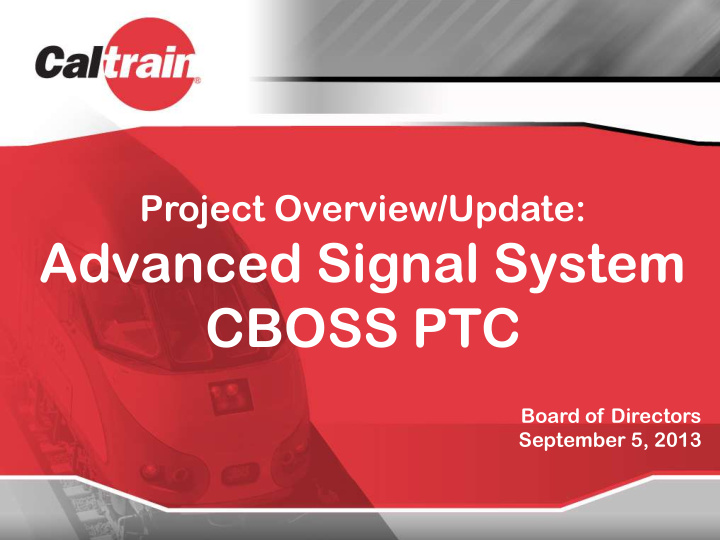



Project Overview/Update: Advanced Signal System CBOSS PTC Board of Directors September 5, 2013
CBOSS PTC - What is it? • Communications Based Overlay Signal System Positive Train Control • Fiber Optic Network • Project Requirements – Includes federal mandate (PTC) – Improves Caltrain performance • Project Partners – Federal Railroad Administration, Union Pacific, California High-Speed Rail Authority • Needed for Blended System 2
CBOSS PTC Requirements • PTC – Prevent train-to-train collisions – Prevent over speed derailments – Prevent incursions into established work zones – Prevent movement through a misaligned switch – Interoperability • Caltrain – Enhanced crossing safety / performance – Improved headways and operational flexibility – Enforcement of scheduled station stops – Schedule management – Employee In Charge 3
Project Total Cost and Milestones Cost Description Milestones (in millions) Project Planning and $5 2010 - 2011 Procurement 2012 – 2013 Phase 1 - Critical Design $25 Phase 2 - Final Design, Data 2013 – 2014 Communications Subsystem & $51 Fiber Backbone Installation 2014 – 2016 Phase 3/4 - Installation, Testing, $150 (Revenue service Commissioning Oct. 2015) Total $231 4
Segments – South to North Segment 1 (SSF – SF) 8 Miles Segment 3 SJ Santa Clara (S of Lafayette St) Segment 2 Santa Clara (N of Lafayette St) Sunnyvale Mountain View Segment 2 (Santa Clara - SSF) 36 Miles Palo Alto Menlo Park Atherton Redwood City San Mateo County San Carlos Belmont San Mateo San Bruno SSF (S of Oyster Point) Segment 1 SSF (N of Oyster Point ) Brisbane Segment 3 (San Jose - Santa Clara) 8 Miles SF 5
Installation Milestones (Entire Corridor) Data Communications Data Communications Subsystem Installation* Subsystem Testing Work Windows: • 8pm – 4 am weekday Wayside Interface Units • 8pm – 6am weekend Installation* • Day work when possible Backup Central Control Facility (BCCF) Office Installation Central Control Facility (CCF) Office Installation Onboard Installation 6 Month Segment 3 CBOSS PTC Static, Segments 2 & 1 CBOSS Demonstration Dynamic, Pre-FRA & FRA PTC Static & Dynamic Testing Testing * Testing * Revenue Service (Oct 15) 2013 2014 2015 2016 6
Milestones (Example San Jose) Fall Winter Spring Summer Fall Winter ‘13 ‘13/14 ‘14 ‘14 ‘14 ‘14/15 Cable Inner-Duct Data One week Two weeks Communications Bore /Trench Subsystem Radio Frequency Base Stations Three weeks Two weeks Installation Wayside Interface Units Wayside Installation Eight weeks Testing Data Communications Subsystem Static Testing Dynamic Testing Test One week FRA Related Testing One week One week TBD 7
Fiber Installation Trench (with mini excavator Conduit placed in trench (~42” deep x 9.5” wide, or by hand, within the Caltrain right of way) within the Caltrain right of way) Potholing (Vacuum-excavation preparing the job site, within the Caltrain right of way) 8
Fiber Installation continued Conduit on tunnel or bridge Boring (required at many (clamps/hangers, may require crossings, within the Caltrain lane closure during off-peak right of way) hours) 9
Base Station Installation Example 80’ pole already Pour foundation on right of way Base station footprint 10
Base Station Map Segment 1 (BS 01, TBS 4, 3, 2 and 1) Segment 2 (BS 09 through BS03) Segment 3 (BS 11, BS10) 11
Base Station Installation • 14 Base Stations within the Caltrain right of way – Many near Caltrain stations – Located within the ROW in the following cities: San Francisco (5) Unincorporated San Mateo County Brisbane Palo Alto Burlingame Sunnyvale San Mateo (2) Santa Clara San Jose • 8 x 8 ft. shelter and 40-80 ft. poles • Average two weeks installation per base station 12
Outreach • Pro-active Approach • Activities (March – August 2013) – City/County Staff Coordination Group (3 meetings) – Local Policy Maker Group (2 meetings) Next meeting follow-up on night work activities – One-on-one (each of the17 cities/3 counties) Provided fact sheets, and tentative jurisdiction schedule Discussed tailored outreach and review process for communication material – Federal and State Staff Quarterly Call Follow-up e-mail with project update 13
On-going Outreach • Project Information Distribution – Website (fact sheets, presentations, FAQ) – Dedicated project hotline line and project e-mail – Weekly updates on website, social media and through construction e-notice – Direct mailers along both sides of the tracks • Next Steps – Permits / Installation coordination – Continue outreach coordination (each jurisdiction) – Continue briefing interested groups, as requested 14
Questions 15
Recommend
More recommend